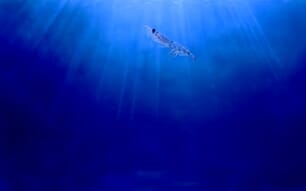Identity
Mytilus edulis Linnaeus, 1758 [Mytilidae]
FAO Names: En - Blue mussel, Fr - Moule commune, Es - Mejillón común
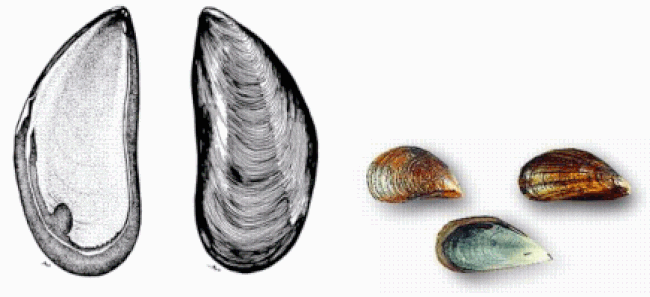
Biological features
Shell solid, equivalve; inequilateral, beaks at the anterior end; approximately triangular in outline. Hinge line without teeth but with 3 to 12 small crenulations, under the umbones. Margin smooth. Pallial line wide; anterior adductor scar very small, posterior large.
External ligament much concealed, extending more than half-way from the beaks to the highest point of the shell. Sculpture of fine concentric lines. Colour purple, blue, sometimes brown, occasionally with prominent dark brown to purple radial markings. Periostracum almost black, dark brown, or olive; interior pearl-white with a wide border of purple or dark blue.
Click here to view SIDP Species fact sheet
Profile
Historical background
Mytilus edulis has been harvested for centuries. Blue mussel shells have been found in kitchen middens dated at 6000 BC. Until the 19th century, blue mussels were harvested from wild beds in most European countries for food, fish bait and as a fertiliser.
The initial step for mussel aquaculture was based upon storage and relaying fishery products. The intertidal wooden pole culture, called "bouchots" dates back to as early as the 13th century in France. This technique spread widely along the French Atlantic coastline over the 19th century, while Northern European countries developed subtidal culture using on bottom culture plots.
The rental of mussel culture plots in the early 19th century resulted from the overfishing of natural beds. At the turn of the 1970s, traditional culture was improved by new technological developments using suspended (rope) culture (longlines). While wild beds are still in use for juvenile supply in several countries, reliability was obtained through the development of spat collecting techniques (ropes, shell). Introductions of Mytilus edulis, as well as technology transfers, have facilitated blue mussel culture in countries outside its native range (eg China). The development of hatchery techniques using polyploid mussels is the most recent culture trend.
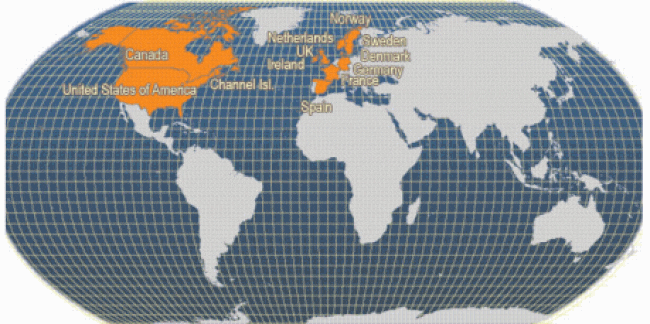
© FAO Fishery Statistics, 2006
Habitat and biology
Blue mussels are widely distributed in European waters, extending from the White Sea, Russia as far as south as the Atlantic coast of Southern France. Mytilus edulis has a wide distributional pattern, mainly due to its abilities to withstand wide fluctuations in salinity, desiccation, temperature, and oxygen tension.
Therefore, this species occupies a broad variety of microhabitats, expanding its zonational range from the high intertidal to subtidal regions and its salinity range from estuarine areas to fully oceanic seawaters. Highly tolerant of a wide range of environmental conditions, the blue mussel is euryhaline and occurs in marine as well as in brackishwaters (Baltic) down to 4 percent, although it does not thrive in salinities of less than 15 percent and its growth rate is reduced below 18 percent.
Blue mussels are also eurythermal, even standing freezing conditions for several months. The species is well acclimated for a 5-20 °C temperature range, with an upper sustained thermal tolerance limit of about 29 °C for adults. Its climatic regime varies from mild, subtropical locations to frequently frozen habitats. M. edulis typically occurs in intertidal habitats, although this distribution appears mostly controlled by biological factors (predation, food competition) rather than by its capacity to survive subtidally, as demonstrated by offshore mussel culture using longlines.
When predators are lacking, M. edulis subtidal aggregations can reach a 1.2 m thickness and individuals attain large sizes in a relatively short period of time. Although blue mussels can live up to 18-24 years, most cultured mussels are produced in less than 2 years. In the wild, M. edulis settles in patches of open spaces, quickly building a dense population referred to as "mussel beds". Although showing a seasonal pattern, the reproductive cycle of M. edulis can exhibit considerable temporal and spatial variation.
Gonads are usually ripe by early spring in European waters; mussels commonly show a significant loss of condition following spawning. Rapid gametogenesis leads to fully ripe gonads again in summer. Although directly driven by food availability and temperature, reproductive cycles in M. edulis may vary latitudinally, both in terms of onset and duration.
High fecundity and a mobile free living larval phase are two characteristics that have contributed to the development of mussel culture; in fact, the natural abundance of M. edulis larvae has been the key for such development.
Production
Production cycle
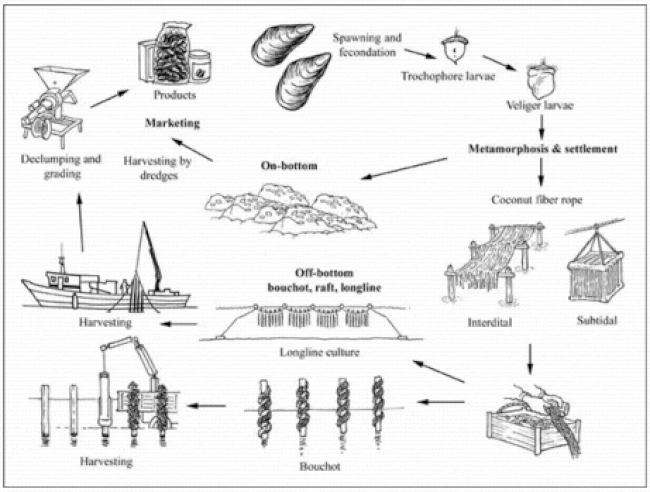
Production systems
Seed supply
Most mussel culture depends on the use of natural spat because of the generally abundant supply. However, hatchery technology is available.
Natural spatfall
Mussels are characterised by high fecundity and a mobile free living larval phase, which have facilitated its widespread distribution. Seed availability therefore greatly influences which culture techniques are used. When using wild seed, various spat collectors are employed, including polyethylene and palm-coconut fibre ropes.
Hatchery production
One of the key issues for mussel culture is seed supply. Hatchery-produced seeds were initially used during the 1970s in China to supplement wild set spat; but now there is a reliable and abundant supply there, sufficient to sustain present production.
Shellfish hatcheries enable the industry to produce seed consistently and at an acceptable cost, as well as to work with polyploids, hybrids, and selected strains. Although the use of hatchery spat production is not yet commonplace, this technology may also provide an option for addressing the irregular spat settlement that has affected natural populations over the last 10 years in European waters.
Hatchery production is based upon conditioning adult mussels by using algal food and temperature control. The natural maturation cycle is actually mimicked at the hatchery. Mature mussels are cleaned up and hung as a group in larval tanks. M. edulis spawning is induced by thermal shock or by stripping.
Once spawning is completed, 24 hours are required for the larvae to reach the straight hinge stage. Larvae are fed ad libitum and allowed to grow until they are ready to set onto ropes (13-15 days). Deployed in setting tanks, mussels are transferred at a 1 mm size to a nursery, where they will remain until they reach 6-10 mm; then the spat is moved outdoors into grow-out systems.
On-growing techniques
The rapid growth rate of mussels ensures that a marketable sized product can be reared in a short time period (<2-3 years). The fact that they use byssus threads to attach themselves to any firm substrate facilitates farming, and represents a distinguishable feature from other cultured molluscs. Several techniques are used for on-growing, including tidal (on-bottom and bouchot type) and subtidal (on-bottom, raft and longline), as described below.
On-bottom culture
Extensive on-bottom culture is based on the principle of transferring mussel seed (spat) from areas where they have settled in great abundance to culture plots where they can be re-laid at lower densities to obtain improved growth and fattening, and to control predation. Seed is dredged from the bottom of the seabed and then re-laid into growing sites (tidal or subtidal plots), where carrying capacity is optimal.
The growing sites are usually prepared, to stabilise the bottom before seeding. Although variable, it is considered that around 1 tonne of marketable mussels can be harvested from 1 tonne of re-laid spat (including the debris dredged with it). A 25-30 tonnes/ha stocking biomass (half-grown mussels) re-laid in spring takes 14-24 months to mature (yield 50-70 tonnes live weight/ha). Mussel growers must remove predators and macroalgae during the rearing cycle to facilitate growing. A re-watering process can be carried out before marketing to eliminate weak and damaged mussels.
Bouchot culture
The bouchot technique, which may combine spat collection with on-growing, has not drastically changed since its origin (13th century) in France. Wooden poles are set into the intertidal seabed in rows (bouchots). Each pole is 4-7 m long, 15-25 cm in diameter, and protrudes 2-3 m above the seabed. Several types of wood are currently used, including pine, oak and, more recently, Brazilian squared hardwood.
The rearing structures are 50-60 m long, with 120-130 poles in single or double lines for spat settlement and 80-90 poles for on-growing. Bouchots should be spaced 25 m apart. Spat settlement occurs intensively in spring directly onto the wooden poles or onto the horizontal coconut fibre ropes strung on the poles before settlement. The seed is then transferred in summer to tubular nets that are reattached around the growing poles. The mesh tubes are nailed on at both ends. Eventually, mussel seed spreads to cover the entire pole. Each pole produces around 60 kg live weight of mussels.
Raft culture
To expand mussel production, Maine (USA) mussel producers are developing suspension culture using 12 m triple pontoon raft systems. Each raft produces 45 tonnes of mussels in an 18 month rearing cycle.
Longline culture (rope culture)
This practice is the most recent development for mussel culture. Although various types exist, subsurface longlines have been developed in France to resist storm and wave effects, and are particularly adapted to areas showing high tidal cycles. This technique allows highly mechanised culture and yields 18-20 tonnes/ha/yr. A multi-longline system has also been developed in Norway and Sweden, using 7-9 headlines.
Temporarily submerging mussel longlines is part of a farming practice designed to lower the crop below surface ice during winter months (Canada). Control of buoyancy is necessary for this system. Floats are connected together by horizontal lines that support a large number of vertical ropes where mussels are grown. Seed is either caught on collector ropes hung from the floating lines, or gathered from natural settlement in intertidal areas. Thinning and reseeding onto grow-out ropes or into stockings are carried out until the mussels reach marketable size.
Harvesting techniques
Once the mussels reach a marketable size (about 40 mm, which takes 12-15 months), various harvesting techniques are used, depending on the area and rearing practices. Mussels grown on wooden poles are harvested by hand or, more commonly, by using a hydraulic powered system that removes all the mussels at once. A cylinder is lowered to the bottom, closed, pulled up and mussels are dumped into a trailer or into inboard containers. Hydraulic forks are also used for unloading. Dredges are currently used for on-bottom culture; an example is the four steel dredge (1.9 m wide) system operated by a hydraulic or pneumatic 8-drum winch in the Netherlands. On hard bottoms, round steel ground dredge bars are provided with 2x2 cm steel blades.
Handling and processing
In unpolluted areas, dredged mussels are cleaned, and sorted by size directly on the decks of the boats with automatic equipment. M. edulis can also be temporarily stored in re-watering plots where they remain for 2 weeks, during which they excrete mud, grit and sand and recover from dredging stress. Then they are transferred to processing plants, where automatic equipment is currently used for washing, de-clumping, de-byssing, and grading. Marketable mussels are packed in 15-25 kg bags and normally sold for the fresh market. However, blue mussels are marketed in several other ways: frozen – ice packed - vacuum packed, cooked and processed.
In the Netherlands, automated equipment is used for washing, de-clumping, grading, and de-byssing, followed either by direct marketing (70 percent fresh market) or by continuous pressure cooking, as well IQF (Individually Quick Frozen) freezing. In Denmark, it is considered that longlined mussels will only be commercially successful if sold live, because of high operating-labour costs. These products are not able to compete with the wild mussels that are destined for canning (boiled and put into jars or tins). Live mussels can be exported in plastic or jute bags, either for the fresh market or for the processing industry that boils mussels for sale.
Mussel commodities are also produced: boiled mussels for single frozen and garnishing; canned non-perishable commodities such as mussels in butter, or smoked and packed in oil in tins. Perishable mussel commodities are also produced, such as mussels in vinegar that are sold in jars, tins and buckets. Almost the entire French production is sold directly for the fresh market. In China, part of the production is marketed fresh but most is steamed and dried. Some mussels are also cooked to produce oyster sauce, or directly used as feed for cultured shrimp and Rapana snails.
Production costs
Production costs are highly variable; cost effectiveness depends directly on site productivity, rearing density and cultural practices. The use of automatic equipment or dredges which reduce labour costs tends to optimise profitability. The level of supply, as well as competition from wild fishery production, affects market prices and therefore the overall yield. Moreover, spat supply and the rate of predation by ducks, seagulls and crabs are significant factors in determining overall production costs and yields.
Diseases and control measures
| DISEASE | AGENT | TYPE | SYNDROME | MEASURES |
|---|---|---|---|---|
| Parasitic infection | Marteilia maurini | Protozoan | Potentially lethal; haemocyte infiltration of digestive gland (connective tissue and epithelia); extensive destruction of the digestive gland in heavy infections | No curative measure; prevention & site selection; monitoring mussel transfer |
| Viral disease | Picornaviridae-like virus | Virus | Heavy mortalities | No curative measure; prevention & site selection; monitoring mussel transfer |
| Vibriosis | Vibrios | Bacteria | Not specified | No curative measure; prevention & site selection; monitoring mussel transfer |
| Rickettsiosis | Rickettsia-like organisms; Chlamydia-like organisms | Bacteria | Microcolonies in the epithelial cells of the gills and digestive gland | No curative measure; prevention & site selection |
| Various parasitic infections | ||||
| Steinhausia mytilovum | Micro-sporidian | Infects cytoplasm of mature mussel ova; incites a strong haemocyte infiltration response | No curative measure; prevention & site selection; monitoring mussel transfer | |
| Cliona | Sponge | Penetrates the periostracum forming holes in the outer surface and a tunnel network throughout the shell | None | |
| Prosorhynchus sp | Bucephalid trematode | Mantles show abnormal colouration (patchy yellow-white) in heavily infected individuals; castration; weakness; gaping | None | |
| Prosorhynchus sp | Bucephalid trematode | Mantles show abnormal colouration (patchy yellow-white) in heavily infected individuals; castration; weakness; gaping | None | |
| Pea crab parasites | Pinnotheres pisum | Crustacean | Reduces market value | No curative measure; decrease stocking density |
| Red "worm" diseases | Mytilicola intestinalis; Mytilicola orientalis | Copepods | Usually commensal but may retard growth | No curative measure; decrease stocking density |
With regard to shellfish regulations, preventive measures aim to limit imports only from countries where no outbreak of disease occurs according to the list specified by OIE International Aquatic Animal Health Code (notifiable pathogens). Although not a notifiable pathogen, the protistan parasite Marteilia maurini is hosted by the blue mussel, in contrast to the notifiable M. refringens, the oyster epizootic parasite.
This indicates that mussel movements are not affected by legal regulations on notifiable diseases. Although high mortalities caused by parasites or infectious diseases have not yet been encountered in M. edulis, several parasites may be potentially harmful. Mussel transfers with parasites must be conducted with caution. Monitoring M. edulis populations and parasites is critical to prevent and limit associated risks.
Suppliers of pathology expertise
Assistance can be obtained from the following sources:
- European Shellfish Zoosanitary Reference Laboratory, IFREMER La Tremblade, BP 133, 17390 La Tremblade, France.
- Instituto de Investigaciones Marinas Consejo Sup. de Invest. Cie., Eduardo Capelo 6, 36208 Vigo, Spain.
- University of Prince Edward Island, Faculty of Veterinary Medicine, Charlottetown, PE C1A 4P3, (Canada).
- Department of Fisheries, Marine Fisheries Research Centre, Abbotstown, Castel Dublin 15, Republic of Ireland.
- CIDC Lelystad, Institute for Animal Disease Control, PO Box 2004, 8203 AA Lelystad, The Netherlands.
Statistics
Production statistics
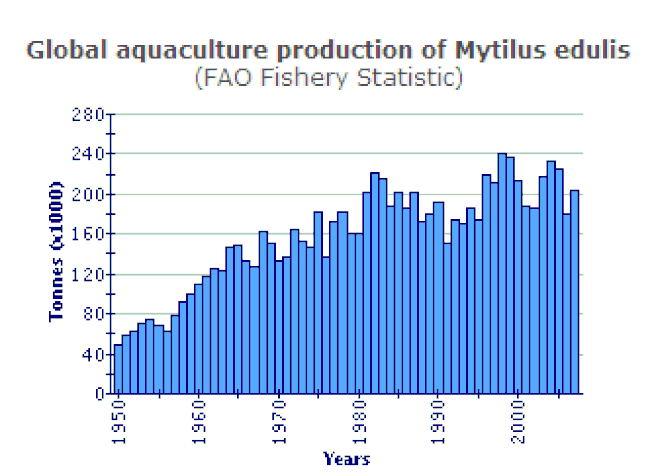
© FAO Fishery Statistics
The global farmed production of blue mussels was 29 percent higher in 2002 (446,000 tonnes) that in 1991 (346,000 tonnes). However, this conceals the fact that production was extremely variable. During that decade a peak of over 500,000 tonnes was achieved in 1998, since which there has been a general decline.
Production in France remained almost steady during this period but has shown a generally increasing trend in Ireland and the UK. Production in two of the major producing countries, Spain and the Netherlands was very variable, contributing to the overall global trend. Blue mussel production is concentrated in Europe, but there is a significant quantity reared in North America and a little in Namibia.
Market and trade
Europe has traditionally been a high-value market, with prices in 2000 ranging from USD 1 700/tonne in the UK to USD 1,200-1,550 in France and USD 450-850 in the Netherlands. Value is affected by the culture technique and concomitant labour costs, which range from USD 400 to 1 600/tonne for dredged and rope cultured products respectively.
Prices for farmed mussels are also affected by irregular landings from the wild fishery. International mussel trade has risen consistently over the last 20 years in terms of total volume as well as in exports as a percentage of domestic supply (eg Europe, 14 percent to 35 percent in 1985 and 2000 respectively).
The import-export market for fresh M. edulis is driven either by seasonal meat quality and/or low supply. France imports half of its annual consumption, mainly M. edulis, from northern countries (September to April) and M. galloprovincialis from southern countries (May to August). This results from an increasing demand for fresh products and also from the seasonally reduced meat quality of M. edulis following spawning. This stimulates import/export trade since simply increasing production does not address this issue.
Exports mainly comprise processed products, which provide added value, and may be a major driving factor for M. edulis culture development. In the Netherlands, part of the extensive dredged mussel culture is processed for cooking, canning, and freezing, as well as to produce a variety of commodities. It is the view of the Irish industry that rope mussels do not travel live as well as bottom cultured mussels. Therefore, 80 percent of Irish rope production was processed in 2001; then in 2002, processors imported fresh mussels from Spain, Greece and other countries because they had exhausted Irish supplies. In 2001, the volume of the Irish processed mussel product range comprised 74 percent vacpack frozen, 13.5 percent vacpack chilled, 7.5 percent IQF in shell and 5 percent others (meats).
Import prices tend to be lower compared to export prices, reflecting the role of processing in this market, and facilitating international trades when local production cannot sustain the demand.
Status and trends
In Europe, most of the mature, large scale producing nations, such as France and the Netherlands, have become broadly stabilised in terms of production; the main source for incremental output with the present technology will be from peripheral nations (UK, Norway, and Ireland). Canada and Ireland markedly increased their farmed output between 1993 and 2002. Forecasts for the mussel industry are that there is likely to be a greater emphasis on processed products (prepared dishes) rather than on the live on-shell market, and that higher competition for raw material might be the near future limiting factor.
Main issues
Besides bird predation and water quality deterioration caused by pollution, which are likely to impose further constraints on the expansion of existing mussel farming operations, two main problems for the mussel industry can be linked closely to its future development: seed shortages and biotoxins that lead to long-term industry closures.
Seed shortages
Seed shortages have affected the mussel industry in several European countries over the last ten years. Three case studies can explain the present situation:
- In Ireland, the dredged sector has witnessed a drastic production increase with no real plan for sourcing seed to support this development; this has led to seed shortages and the risk of over-exploitation of natural beds. The 2003 seed requirement was estimated to be 180,000 tonnes, but the supply was around 30,000 tonnes. Seed supply can be improved by a better understanding of spat settlement and improved survey and management practices.
- In the Netherlands, irregular yearly recruitment led to repeated seed imports from Germany, Belgium, France and the UK. The quantity of spat removed by the farmers from natural beds has been determined by a survey. A large part of those beds have been recently closed, to create a food reserve for eider ducks and oyster catchers; this has led to a decreasing spat quota per farmer.
- Global climate change may also affect spat recruitment and seed supply: the summer of 2003 was characterised by an abnormal heat wave in French waters, leading to massive mussel spat die-offs in >26 °C seawater temperatures. A significant mussel population change would occur if it were to become a more regular occurrence.
Biotoxins
The extent and scale of impact of the various biotoxins in Europe and North America is well documented by the on-going monitoring networks and quality controls developed to protect the public from diarrohetic shellfish poison (DSP) and paralytic shellfish poisoning (PSP).
PSP and DSP toxins have been recorded throughout the European continent, as well as in the Gulf of Maine.
However, ASP (domoic acid) has been less frequently reported, but has been noted in eastern Canada and North America, causing illness and deaths, and in Spain, Ireland and Scotland. Its impact makes it one of the most economically destructive biotoxins, with associated long-term industry closures, and sales prohibitions. In addition, AZP (azaspiracid poisoning) resulting from a dinoflagellate species (Protoperidinium sp.) has been reported in Ireland as causing human health problems.
While the cultivation of blue mussels has shown great potential in several countries, the inability to control algal toxins is a major limiting factor. Depuration is a likely potential option for the shellfish industry, to manage the impact of shellfish toxins.
Responsible aquaculture practices
Although it has a limited impact, which is usually reversible since no artificial food or chemical treatments are involved, mussel culture should be conducted in a sustainable way by using an ecosystem approach. Appropriate site selection procedures and integrated coastal zone management planning are useful to limit potential side-effects. Various environmental impacts have been reported including:
- Seed dredging effects on bottom and benthic communities.
- Deposition of organic matter below the rearing structures – deposits can result in an increase of several centimetres of sediment a year, inducing changes in sediment composition and benthic community structures.
- Carrying capacity issues and food competition when overstocking occurs.
- Invasive patterns when introduced into a new ecosystem.
Overall issues, including a precautionary approach when using genetically engineered strains, have been extensively reported and can be addressed by implementing the FAO Code of Conduct for Responsible Fisheries (Article 9: Aquaculture Development), the ICES Code of Practices for Introduction and Transfer of Marine Organisms, and the recommendations for sustainable aquaculture from the Convention of Biological Diversity.



